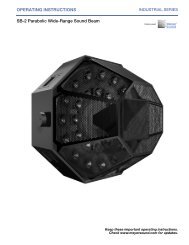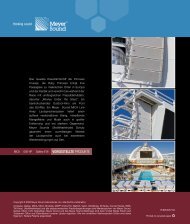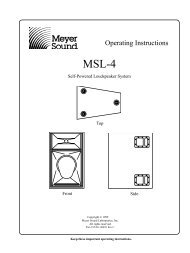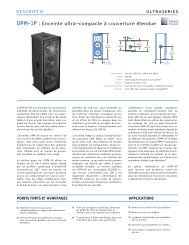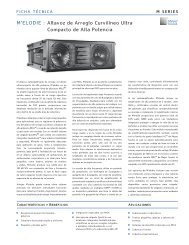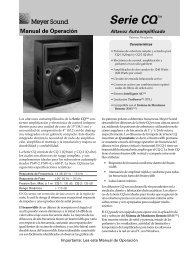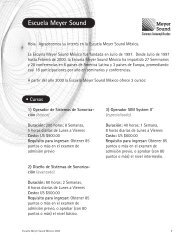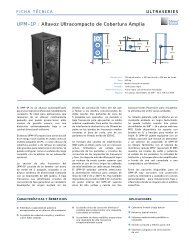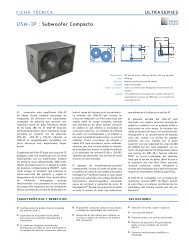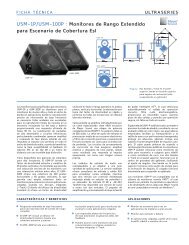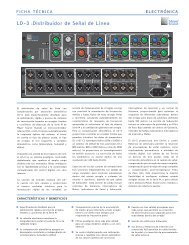Northland Church Case Study - Meyer Sound Laboratories Inc.
Northland Church Case Study - Meyer Sound Laboratories Inc.
Northland Church Case Study - Meyer Sound Laboratories Inc.
Create successful ePaper yourself
Turn your PDF publications into a flip-book with our unique Google optimized e-Paper software.
Constellation Settings<br />
For the purposes of electroacoustic architecture, the Constellation system at <strong>Northland</strong> has three settings plus Off,<br />
allowing the selection of four acoustical room characteristics:<br />
Off: With a midband reverberation time (RT) of about 1.3 seconds, the inherent room acoustics work well for high-level<br />
amplified music, particularly with fast tempos and percussive attacks. Off is also optimum for speech intelligibility.<br />
Short: With a midband RT of 1.7 seconds, the Short setting gives the room a more intimate, enclosed feel. It yields<br />
optimum results for various types of chamber groups and small ensemble instrumentalists. Also, <strong>Northland</strong> engineers<br />
have found this setting works well for the sermon; although not optimum for speech, the extraordinary clarity of the main<br />
PA system maintains excellent intelligibility while Constellation lends the pastor’s voice an “out in the room” presence.<br />
Medium: With a midband RT of 2.2 seconds, this setting is optimized for solo singers and instrumentalists, whether in<br />
worship, recitals or operatic performances.<br />
Long: With a midband RT of 3.0 seconds, this setting works well for romantic orchestral works and large choirs. It also<br />
provides the simulation of a large reverberant space to complement electronically sampled pipe organ sounds, when<br />
desired, as <strong>Northland</strong> does not have a physical pipe organ.<br />
Note that Constellation at <strong>Northland</strong> also offers a Very Long setting. This is not shown in the reverberation time graph as<br />
it is not intended for use as natural electroacoustic enhancement. Rather, it is an extreme setting designed solely for use<br />
as a special effect—a cavernous sound that would not be realistic in the given space.<br />
Frequency Balance<br />
Natural-sounding room reverberation requires balanced response across nearly all of the audible frequency range,<br />
including bass frequencies. Note that in the reverberation graph, the shape of the Constellation-enhanced curves closely<br />
emulates the room’s physical reverberation characteristic, even in the lower frequencies. At <strong>Northland</strong>, these mid-bass<br />
frequencies are supplied by the larger two of the three loudspeaker types: the UPM-1P loudspeaker and the UPJ-1P VariO<br />
loudspeaker. (Use of larger loudspeakers was required because of the extreme width and volume of the room; in smaller<br />
halls, a Constellation system will normally employ smaller loudspeakers with bass augmented by compact subwoofers.)<br />
Special Effects and SpaceMap<br />
When used in the “pure” application as electroacoustic architecture, the Constellation loudspeakers throughout the<br />
room receive input only from the Constellation microphones which are spaced throughout the room to provide natural<br />
regenerative enhancement of the physical room acoustics. However, these same loudspeakers can be accessed for use<br />
as a surround sound or special effects system. At <strong>Northland</strong>, the system is configured to allow the main mixing console<br />
to supply an auxiliary send separately to each of the four Constellation zones. In addition, the Constellation system<br />
incorporates the powerful SpaceMap software program, which allows one or more sound sources to be routed separately<br />
to any one of the discrete outputs of the Constellation system. SpaceMap allows preprogrammed dynamic panning of<br />
sounds to and from any output, enabling the sound designer to freely move sounds anywhere within the space of the<br />
room.<br />
User Interface<br />
Constellation is controlled from the front-of-house mix position via a simple web page interface that is provided by the<br />
Constellation primary processor. Five reverberation time settings, five system gain settings, and the ability to mute and<br />
unmute the stage microphones can be controlled independently. This provides flexibility for use with both acoustic and<br />
reinforced events.<br />
Primary <strong>Sound</strong> Reinforcement<br />
Systems<br />
The main sound reinforcement<br />
system utilizes a total of 36 <strong>Meyer</strong><br />
<strong>Sound</strong> self-powered loudspeakers<br />
to provide highly intelligible,<br />
uniform coverage throughout all<br />
auditorium seating areas. The full<br />
bandwidth response, along with<br />
extraordinary headroom reserves,<br />
makes the system fully suitable<br />
for any type of contemporary or<br />
traditional musical performance.<br />
The system is anchored by MILO<br />
line array loudspeakers, which are<br />
accepted on the riders of nearly<br />
all major touring artists in the<br />
world, Christian or secular.<br />
16 MILO line array loudspeakers<br />
2 CQ-1 loud speakers<br />
2 CQ-2 loudspeakers<br />
6 UPJ-1P VariO loudspeakers<br />
4 UPM-1P loudspeakers<br />
6 M3D-Sub directional subwoofers



